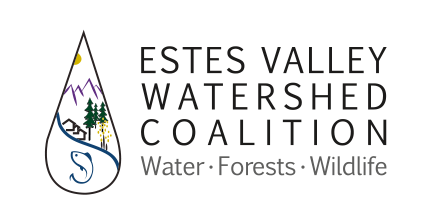Why Thin our Forests?
Welcome back to our 4-part series on the fascinating dynamics of forests and fires in the Estes Valley!
The Estes Valley Watershed Coalition (EVWC) was fully immersed in forest health projects this past summer. In July my co-worker, Wilynn, and I were doggedly hiking steep inclines, carrying heavy supplies, and getting splattered with blue paint from head to toe. Thankfully, we were joined by our wonderful partners from the Estes Valley Fire Protection District (EVFPD), the Colorado State Forest Service (CSFS), the Larimer Conservation District, and representatives from the Thunder Mountain HOA. Our mission that day was to spray blue paint marking trees for removal on the conservation easement between the Thunder Mountain neighborhood and Rocky Mountain National Park. We followed directions from the CSFS outlining the need to change the forest composition to protect homes, mitigate fire risk, and promote forest health through thinning.
Due to a century of fire suppression, this forest—like most in the Estes Valley—had become unhealthy and overgrown. It was filled with dangerous amounts of flammable dead wood and was overcrowded with trees. Unfortunately, many of the Lodgepole Pines and some Ponderosa Pines were infected with dwarf mistletoe, a parasitic plant that reduces growth, vitality, and seed production. Dwarf mistletoe spreads easily, increases flammability, and eventually kills its host trees.
Understandably, many people in the community are concerned about removing trees and wish the forest could remain in its current state. But here's the fascinating thing: historically, our forests have evolved and thrived with regular, moderate fires every 20-100 years...except for the last 120 years or so. In our lifetime, we’ve only known unhealthy forests. Forests' true natural state, in evolutionary partnership with fire, was before our time. Without low-grade fires to clear out dead wood, forests become more prone to high-intensity fires and trees have much higher mortality rates.
All of the current EVWC forest health projects are thinned by hand since the steep angle of our local terrain is prohibitive to using machines. Hand thinning is primarily used to remove small diameter trees, sometimes called ladder fuels, from tree stands that are too dense. Thinning serves to modify fire behavior by reducing wildfire hazards and forest density. It also improves wildlife habitat and improves the vegetation diversity in the understory. While it may seem initially counterintuitive, in the absence of historic fire regimes, thinning trees is a very effective strategy to reduce the risk of catastrophic wildfire impacts.
Join Our Mission: Estes Valley Watershed Coalition (EVWC)
The mission of the Estes Valley Watershed Coalition (EVWC) is to bring together local, state, and federal partners to collaborate on projects that support the water, forests, and wildlife of the Estes Valley. Visit us at evwatershed.org
Learn more about the benefits of forest treatments:
Understanding Fire Severity through Five Colorado Wildfires, Colorado Fire Restoration Institute
Fire Behaves Differently in Different Types of Forests, Colorado Fire Restoration Institute
Types of Forest Treatments, Northern Colorado Fireshed Collaborative

